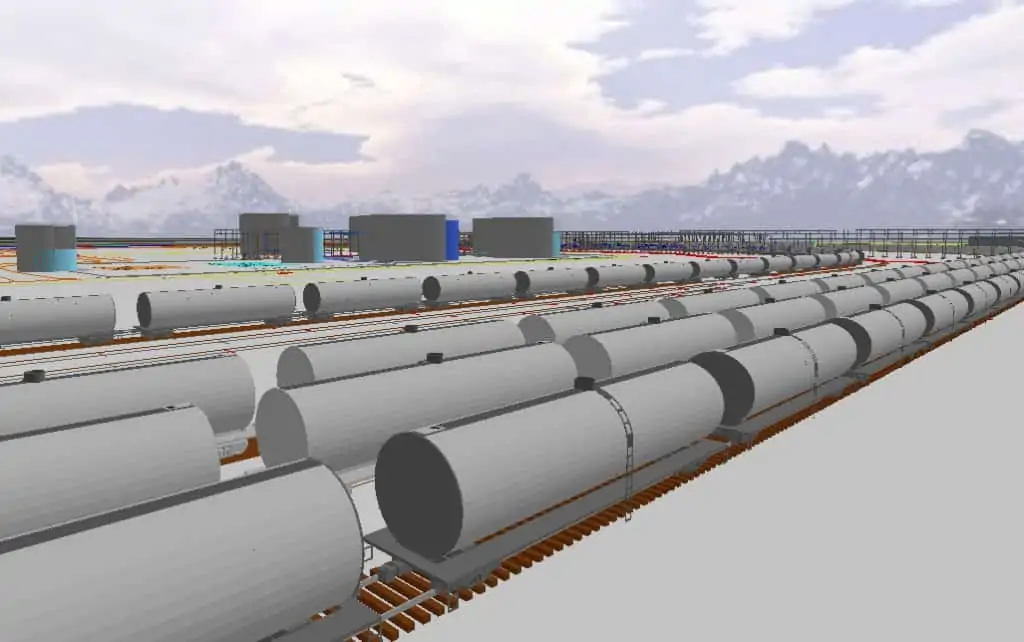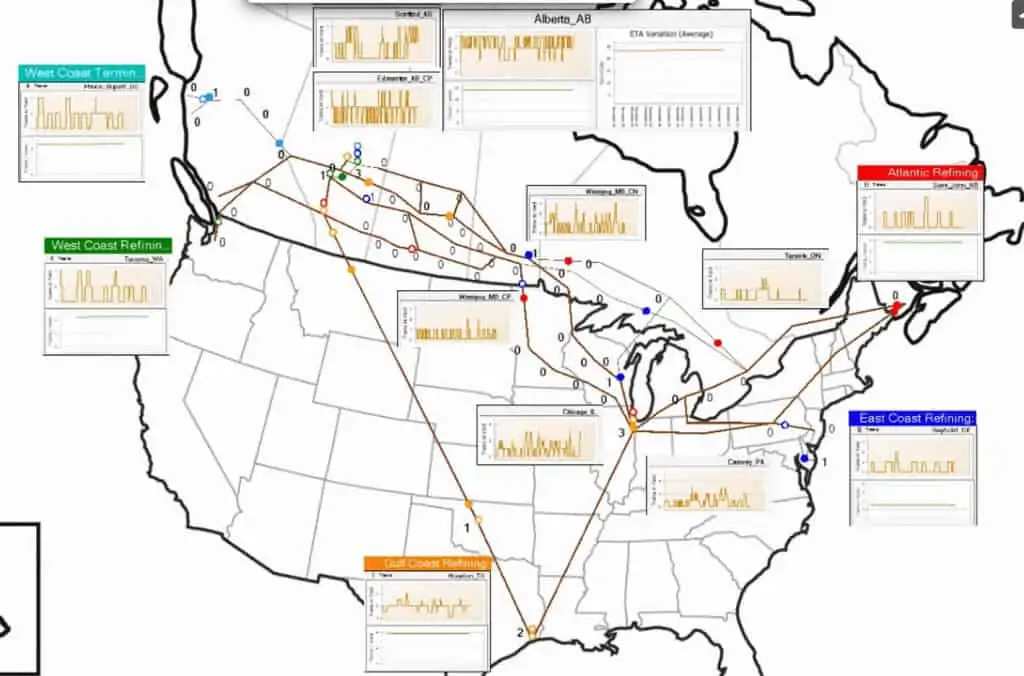
A midstream petroleum company was designing and developing improvements at an existing facility to increase their crude-by-rail terminalling and transloading business, accomplished by expanding and reconfiguring their rail / truck infrastructure to create a new interface point between pipeline and rail transport. The company recognized the need to apply modeling and simulation technology to represent the new crude loading system in a dynamic environment, therein incorporating inherent variability, to validate the design and make informed decisions. There was the specific need to verify the process design throughput of the loading facility, in the holistic context of the anticipated logistics and business/market environment. This paper reviews the approach and value of applying dynamic simulation in the petroleum industry as it relates to this specific project.
System Description
Based in Calgary, Alberta, Canada, the company has been providing chemical manufacturing and handling services for more than half a century. Recognizing its strategic location, the company transformed and expanded the site of their former chemical plant and Rail/Truck manifest terminal into a crude oil storage and transloading facility to efficiently service the vast oil & gas sectors in Alberta.
The new terminal has direct access to both of the Canadian Class I rail operators, and is ideally located within Alberta’s Industrial Heartland in close proximity to pipeline corridors serving oil sands and heavy oil reserves in the northeast areas of the Province. These pipelines transport product to multiple re-fineries in the Industrial Heartland, but also link to a number of terminalling operations and major cross-country pipelines to eastern and western Canada and US markets. In response to the need for additional capacity in moving Alberta Crude to markets, the project was developed in incremental capacity phases, a new unit-train transloading terminal with two loading/unloading tracks, multiple loading positions, and a number of bypass tracks for additional gathering, staging, storage, and distribution. To supply the loading operation, on-site crude storage for two distinct products and a new 10 km long lateral pipeline was in-stalled with tie-in access to two major pipelines. An additional lateral pipeline for returning back-hauled condensate and diluent to the pipeline corridor was installed in the same trench as the supply line. Feeding from the storage tanks, a bank of large loading pumps connected through manifolds to either set of loading arms allowing multiple concurrent unit train processing.
Two simulation models were developed to analyze the terminal operation:
- Terminal Model provided a detailed representation of onsite unit train operations and product fluid flow.
- Network Model provided a high level perspective of the terminal integration with the rail network between origin and destination points across North America.The Problem and Approach
Ultimately, the dynamic simulations were used to not only confirm and optimize throughput, but the simulation software can also be leveraged for sophisticated operational planning and scheduling solutions.
Project Execution
The modeling work was completed in a staged approach (refer Figure 1), in conjunction with the standard steps of engineering design. The results of the FEED phase of engineering was confirmed with the terminal model at an early stage and the terminals true potential identified. While Detailed Engineering Design was underway, the higher-level network model was developed to help understand the complexity of linking potential customers with the terminal via the available rail networks, and used by the customers business development team to aid their sales efforts for securing additional contracts for the new terminal.

The models were utilized through startup and commissioning, and then were re-tuned with actual operating performance statistics derived from the control system historian and operation’s ongoing KPI data gathering. Once the models were matching current performance, it was handed over to the operations group at the terminal for ongoing use in training staff and optimizing operations.
Terminal and Network Models
The terminal model required detailed representation of various system components, including rail movements into, within, and out of the terminal, and product flow through pipelines, large floating roof crude tanks, loading pumps, headers, and individual loading arms. A discrete event simulation (DES) model was developed, with major fluid flow aspects and accommodation for pressure drop in the loading rack.
The network model represented a much higher level of abstraction of the North American rail system though, including terminal locations, siding capacity and locations, single and double track configurations, bottlenecks and queuing times, as well as rail loading and unloading times for the unit train design. The model integrates with private and public information sources of the rail systems including traffic and existing infrastructure across multiple rail companies. DES model was developed, providing both visualization of the unit train movements along the large rail network as well as detailed statistics of the system.
Benefits
The company realized that their investment in dynamic modeling and simulation would not only be used during the design but was also able to be used in ongoing operations to provide insight and optimization opportunities for their new facility. The benefits achieved include:
Infrastructure Design Analysis: Capability allowing supply & demand based inbound and outbound traffic pattern scenario testing; validation of practical throughput capacities; validation of turnaround, waiting times, demurrage; validation of peak infrastructure utilization; and identification of bottlenecks. Operating Policy Development: Capability allowing supply & demand based scenario testing of throughput based on operating mode; impact analysis of operations of infrastructure reliability, seasonality, weather, and other risk events; and operating costs analysis of different operational strategies. Transportation Coordinator Training: Capability allowing training of operations personnel for improved operational efficiency and safety; and simulation of planned and unplanned scenarios.
Business Development Analysis: Capability allowing throughput capacity modeling for new customers, and other similar what-if scenarios; studies on suitability of existing infrastructure for handling new product; support for validating different contractual arrangements with customers; and support for future design development of ongoing projects and operational changes.
Future Potential Real-time Terminal Optimization System: In providing the basis, specification and input to the design and validation of a future potential Real-time Optimization systems for the Terminal.
As with many modeling projects, benefits lie in the Journey, as well as the Destination. Through the process of gathering data, and working with the modeling team, the company gained much insight into their virtual operation, and a number of design changes were made at an early stage, where the cost of implementation was relatively minor compared to the expected improvement and returns once operational.
About MOSIMTEC
The MOSIMTEC concept is different from traditional engineering and consulting services. It is based on the paradigm that technology will be instrumental in decision making. Sophisticated computer simulation software in combination with ever increasing processing speed and memory will enable decision support tools to deliver deep insight in a complex, dynamic, and real-time world. The MOSIMTEC team has extensive experience working with leading computer simulation software and solving complex issues for clients across various industries. We are uniquely positioned to support clients in making smart decisions by applying Modeling & Simulation Engineering (MSE) to predict outcomes, prescribe actions and improve operations.
